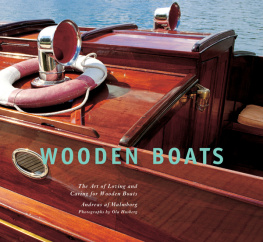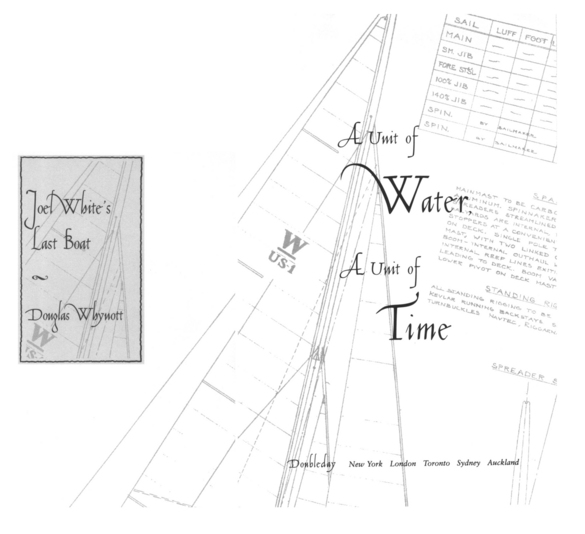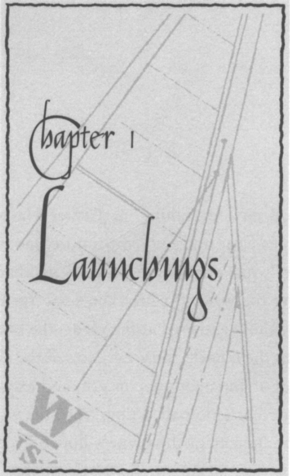
PUBLISHED BY DOUBLEDAY
a division of Random House, Inc.
1540 Broadway, New York, New York 10036
D OUBLEDAY and the portrayal of an anchor with a dolphin are trademarks of Doubleday, a division of Random House, Inc.
Library of Congress Cataloging-in-Publication Data
Whynott, Douglas, 1950
A unit of water, a unit of time: Joel Whites last boat / by
Douglas Whynott. 1st ed.
p. cm.
1. BoatyardsMaineBrooklin. 2. Brooklin Boat Yard (Brooklin, Me.). 3. White, Joel. 4. BoatbuildingMaineBrooklin. 5. Yacht buildingMaineBrooklin. I. Title.
VM321.52.U6W48 1999
623.830974145dc21
98-8670
eISBN: 978-0-307-82034-1
Copyright 1999 by Douglas Whynott
All Rights Reserved
v3.1
For Kathy Olsen

Contents
S ailing is a wonderful and unique thing, and the sensation of being noiselessly and smoothly propelled without cost of fuel is one of the most satisfactory pleasures known, but when you add to this the fact that the sailboat itself is one of the most interesting things which God has let man makewell, then you get a combination which is almost sacred.
L. F RANCIS H ERRESHOFF
A small sailing craft is not only beautiful, it is seductive and full of strange promise and the hint of trouble. If it happens to be an auxiliary cruising boat, it is without question the most compact and ingenious arrangement for living ever devised by the restless mind of man.
E. B. W HITE
P erhaps the first Wanderer will slip into Center Harbor at sunset. The owners, friendly folk, will invite me aboard, and sitting below at the cabin table, I will look around and it will all be just as I imagine itthe feeling of space and comfort, soft highlights glinting off the varnished trim, the combination of aromas that emanate from the interior of a choice wooden vesselcedar, teak, and tar, supper and rum, and the accumulated wind and sunshine of a good days run.
J OEL W HITE
Acknowledgments
Id like to thank the people of Brooklin, those who spoke with me, the many who gave information and advice, good times and conversation. A special note of thanks to Maynard Bray for reading parts of this manuscript and offering technical and historical suggestions. Id like to thank the boatbuilders and workmen at Brooklin Boat Yard, many who talked with me at length, who talked with me during those times when Id sidle up and say, So, what are you doing? Id like to thank the White family for their help, and especially Steve White for letting me wander freely around the yard. I must say thanks to Dorothy Jordan and her six cats for their kind hospitality. And finally, my heartfelt thanks to Kathy Olsen, who gave loving friendship and encouragement, all the way through.
June 1996
Its a good day for sailing, at Center Harbor in Brooklin, Maine. The sky is clear and the temperature has risen through the fifties, and theres just enough of a breeze, gentle on the land and slightly stiff over the water. At Brooklin Boat Yard its a launching day, and among those gathered at the yardthe boatbuilders, those coming to watch the launch, those here to sail the new boatsthere are many shades of anticipation, concern, and excitement. Launching days are big events, after all, a time when the work of the year is revealed and the dreams of the owners hopefully come true.
Two boats are sitting in the yard, up on jackstands, one behind the other. They seem suspended in motion, like stilled thoughts, some element of gravity missing just now (water) and some aspect of time (forward movement). The boatbuilders hurry about, climbing up and down ladders, moving to and from the shop, rigging lines and bending on sails, thirty feet from the dock. Theres a huge mechanical contraption standing nearby, the Travel-lift, soon to pick the boats up in slings and set them into the water, once the high tide has come.
The boats are of a new design called the Center Harbor 31. They are beautiful to look at. The curved lines that run along the surface and toward the bow are instinctively pleasing, comfortable to rest the eye upon. At the bows of both boats are wreathsdressed in ribbons and flowers, wearing lustrous white, with the lovely lines, these two Center Harbor 31s, called Grace and Linda, could seem like two beautiful schoolgirls off to the prom.
They are the product of the design work of Joel White, who began his career as a boatbuilder forty years before, constructing wooden lobster boats with an older boatbuilder. He bought the yard, built many more boats, and as of late has been creating a style of design that has become his own, one that hes become famous forboats simple of line yet sound in engineering, traditional above water and modern below.
Steve White, Joels son, runs the yard now, and through the morning organizes the work on Grace and Linda. He also spends some time rigging, the work he enjoys most. Suspended on a bosuns chair from a hoist on the Travel-lift, he goes about attaching the roller furling jib unit to the mast. Nearby is Bob Stephens, project foreman for the two boats, helping to get the sails on.
The owner of Grace, whose name is Frank Henry, was by early this morning to check on the progress. He and his wife have a summer home in Brooklin. Frank Henry had come up to the yard from New Hampshire several times over the winter to see the progress of the construction and to talk to the boat-buildershed been surprised that the crew had been willing to take time out to talk to him, even though the pressure was on to finish by the launch date. In the fall when they were still in the planning stages, Henry had been in Brooklin to confer with Joel White on the design. He had built Grace in fact, in order to have the experience of participating in the development of a new boat. Grace is the result of that effort and for Frank Henry this is a satisfying day. His children and grandchildren will be at the launching, and his wife, Grace Henry.
Previously the Henrys had owned a 42-foot racing yawl, with eight berths, a charcoal stove, and a supply of hot water. They had raced to Bermuda, cruised the Great Lakes, and sailed to New Brunswick, and the boat was the vehicle of many family memories, but after the Henrys children grew up and got their own families and boats, the 42-foot racing yawl seemed much too big. One afternoon when they were sailing in Eggemoggin Reach the Henrys came upon a red-colored daysailer with beautiful linesJoel Whites personal boat, Ellisha, a fiberglass model called the Bridges Point 24 that Joel designed for a local boatbuilder. When Grace Henry saw Ellisha she said, Now thats more like it.
Frank Henry sailed a Bridges Point 24, and he considered buying one. But Henry wanted something more in a boat, and he wanted an experience in designing it. After talking with Joel White he looked through books about boats and yachting. In












